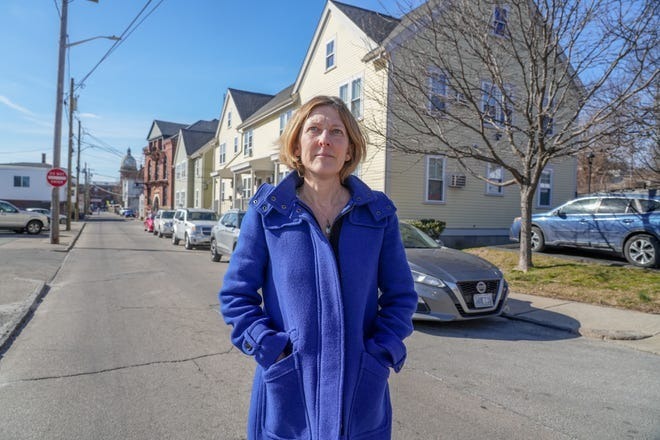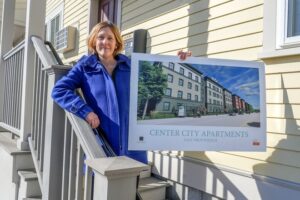
Jennifer Hawkins, CEO of One Neighborhood Builders, an Olneyville-based nonprofit
that is working to build an affordable housing development in East Providence.
David DelPoio photo/The Providence Journal

Jennifer Hawkins, CEO of One Neighborhood Builders, an OIneyville-based nonprofit that is working to build an affordable housing development in East Providence. David DelPoio photo/The Providence Journal
In a Feb. 7, 2024 article in The Providence Journal, Jennifer Hawkins, President and CEO of ONE Neighborhood Builders is quoted explaining why building affordable housing in Rhode Island is so challenging. Building affordable housing is a lengthy, complex process that involves a series of challenges, from local zoning, to parking restrictions, to financing gaps, she said. Hawkins uses ONE|NB’s planned Center City Apartments in East Providence as an example, explaining how it was reduced in scope through the planning process to 144 apartments, increasing the cost per unit and pushing the planned construction date until 2025.
Hawkins, who serves as a member of the Rhode Island House of Representative’s Special Commission to Study the Low and Moderate Income Housing and Rhode Island Housing Resources Commission, explained that nonprofit developers like ONE|NB need to rely upon a host of funding sources, many of which are uncertain. Testifying in January about the proposed funding for Center City Apartments, Hawkins explained: “There’s 21 different and prospective sources that we are cobbling together. Our capital stack, as they say, is like a very, very tall leaning tower of Pisa.”
Hawkins is quoted explaining that the current system of federal tax credits, the main source of funding for affordable housing, also benefits many intermediaries who take a cut of the deal, and that the rising costs of construction, insurance, and interest rates have reduced the amount of affordable housing that can be built with public funds.
Here’s a sample of the article below. Read the entire piece on The Providence Journal website.
By Patrick Anderson
The Providence Journal
Feb. 7, 2024
WARREN – The residents of these quiet side streets east of the Kickemuit River answer their doors when you knock and welcome strangers – unless they’re trying to build 40 apartments in a field next door.
Then they will band together, sticking red-lettered signs on the front lawns urging people to “Stop Penny Lane,” an affordable housing development and the latest battleground in Rhode Island’s housing wars.
“To develop and change our neighborhood is just wrong,” Joan Hunt, a neighbor opposed to Penny Lane told the Warren Planning Commission at a recent hearing. “We are a small coastal community, not an urban one.”
Rhett Nanson, another neighbor, was more blunt.
“The ruse of affordable housing … is just a lie: no one aspires to get an apartment unless you still live in the Soviet Union,” he said. “What is the point of having guidelines if we are going to ignore them? I thought the purpose of them was to keep us from becoming an urban hellscape.”


